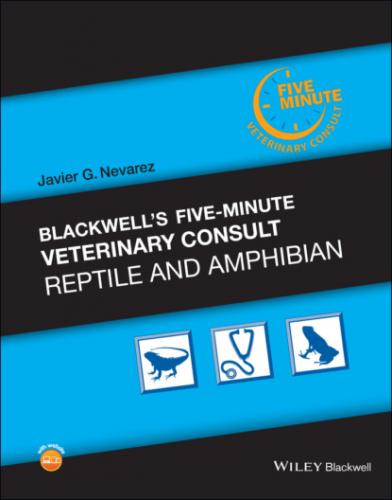A CBC may provide information on the severity of the infection/inflammation.
PATHOLOGICAL FINDINGS
Histology and culture are most useful to diagnose the cause of the exophthalmia and allow the clinician to form an appropriate treatment plan.
APPROPRIATE HEALTH CARE
N/A
NUTRITIONAL SUPPORT
Additional nutritional support is not necessary if the animal is eating, but it may be necessary to tube feed or place an esophagostomy tube if the animal is anorexic.
Assessment of the diet for adequate vitamin A levels is important and should be done to rule out hypovitaminosis A as a potential cause or contributor to this condition in chelonians.
CLIENT EDUCATION/HUSBANDRY RECOMMENDATIONS
While exophthalmia can occur in any animal, those with husbandry deficiencies may be at increased risk.
In addition to medical and surgical therapy, maximizing the husbandry of the animal will improve the chances of a successful outcome.
DRUG(S) OF CHOICE
Treatment should be based on results of culture, histology, and/or FNA.
Starting an appropriate broad‐spectrum antibiotic with a good Gram‐negative spectrum (e.g., ceftazadime 20 mg/kg IM or SQ q48–72h) and anti‐inflammatory (e.g., meloxicam 0.2–0.3 mg/kg IM or SQ q24–48h) can be helpful while test results are pending.
PRECAUTIONS/INTERACTIONS
N/A
PATIENT MONITORING
Serial CBC, especially if the first one was abnormal, may provide an indication of response to treatment.
EXPECTED COURSE AND PROGNOSIS
Prognosis is related to the underlying cause of the exophthalmia.
Cellulitis and trauma have the most favorable outcomes.
Retrobulbar abscesses can be extensive and therefore carry a more guarded prognosis.
Retrobulbar neoplasia usually carries a poor prognosis because of location and inability to get clean margins.
COMMENTS
N/A
ZOONOTIC POTENTIAL
Depends on the cause of the retrobulbar swelling but generally low to no zoonotic potential.
SYNONYMS
Exophthalmos
Proptosis—severe case of exophthalmia
ABBREVIATIONS
CBC = complete blood count
CT = computed tomography
FNA = fine‐needle aspiration
MRI = magnetic resonance imaging
Suggested Reading
1 Boyer TH. Turtles, Tortoises, and Terrapins. In: Mader DR, ed. Reptile Medicine and Surgery. 2nd ed. St. Louis, MO: Elsevier Saunders; 2006:696–704.
2 Hochleithner C, Holland M. Ultrasonography. In: Mader, DR, Divers SJ, eds. Current Therapy in Reptile Medicine and Surgery. Saint Louis, MO: Elsevier Saunders; 2014:107–127.
3 Lawton MPC. Reptilian Ophthalmology. In: Mader DR, ed. Reptile Medicine and Surgery. 2nd ed. St. Louis, MO: Elsevier Saunders; 2006:323–342.
Author Christopher S. Hanley, DVM, DECZM
Follicular Stasis
DEFINITION/OVERVIEW
Follicular stasis is the retention of ovarian follicles. Normally, follicles ovulate into the oviduct or undergo atresia. If neither happens, the reptile is considered to be in follicular stasis. Identifying whether the presence of follicles is pathologic or physiologic is difficult given the fact that, most of the time, the stage of the reproductive cycle in an individual animal is unknown. A diagnosis of follicular stasis is often made once the animal starts showing clinical signs of illness or follicles are present for a longer period than expected for the species.
ETIOLOGY/PATHOPHYSIOLOGY
Follicles can fail to ovulate and undergo atresia for a number of reasons, but in most cases an abnormal hormonal status can be assumed.
The reproductive hormone mechanism in reptiles is not as well understood as it is in mammals.
It is suspected that a multitude of environmental and behavioral factors, as well as underlying diseases, contribute to an abnormal function of the endocrine system, which in turn leads to follicular stasis.
It is also possible that a lack of breeding and exposure to males may have a negative impact on reptiles’ ability to properly ovulate.
Inappropriate or lack of brumation may also be a contributing factor.
In addition to basic husbandry aspects such as UVB light, temperature, humidity, and a proper diet, female reptiles also have a need for appropriate substrate and environment that is conductive for egg laying.
SIGNALMENT/HISTORY
Follicular stasis occurs in female chelonians of reproductive age or size.
Most animals have a history of inadequate husbandry, being housed alone without access to a male, and lacking an appropriate area for laying eggs.
CLINICAL PRESENTATION
Chelonians with follicular stasis often present with non‐specific clinical signs such as anorexia and lethargy.
Other signs that may cue in the possibility of follicular stasis include hind‐limb
